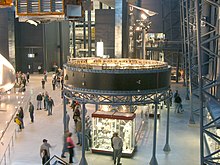
The Saturn V instrument unit is a ring-shaped structure fitted to the top of the Saturn V rocket's third stage (S-IVB) and the Saturn IB's second stage (also an S-IVB). It was immediately below the SLA (Spacecraft/Lunar Module Adapter) panels that contained the Apollo Lunar Module. The instrument unit contains the guidance system for the Saturn V rocket. Some of the electronics contained within the instrument unit are a digital computer, analog flight control computer, emergency detection system, inertial guidance platform, control accelerometers, and control rate gyros. The instrument unit (IU) for Saturn V was designed by NASA at Marshall Space Flight Center (MSFC) and was developed from the Saturn I IU.[1] NASA's contractor to manufacture the Saturn V Instrument Unit was International Business Machines (IBM).[2]
One of the unused instrument units is on display at the Steven F. Udvar-Hazy Center in Chantilly, Virginia. The plaque for the unit has the following inscription:[3][4]
The Saturn V rocket, which sent astronauts to the Moon, used inertial guidance, a self-contained system that guided the rocket's trajectory. The rocket booster had a guidance system separate from those on the command and lunar modules. It was contained in an instrument unit like this one, a ring located between the rocket's third stage and the command and lunar modules. The ring contained the basic guidance system components—a stable platform, accelerometers, a digital computer, and control electronics—as well as radar, telemetry, and other units.
The instrument unit's stable platform was based on an experimental unit for the German V-2 rocket of World War II. The Bendix Corporation produced the platform, while IBM designed and built the unit's digital computer.


- ^ "Instrument Unit Fact Sheet, Saturn V News Reference." Changed December 1968. Page 2.
- ^ Roger E. Bilstein. Stages to Saturn. The NASA History Series, 1996. Chapter 8. From Checkout to Launch: The Quintessential Computer. IBM is also identified as the Instrument Unit builder on the nameplate of IU-514 at Udvar-Hazy Center. This nameplate is at the top left of location 7.
- ^ "Saturn V Instrument Unit (IU) | NASM TAP". copilot.si.edu. Smithsonian Institution. Archived from the original on 2019-04-04. Retrieved 2017-09-22.
- ^ "Saturn V instrument unit audio description". copilot.si.edu/. Smithsonian Institution. Retrieved 2017-09-22.